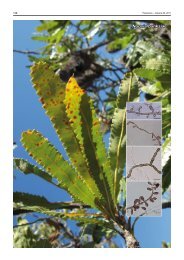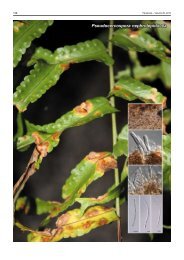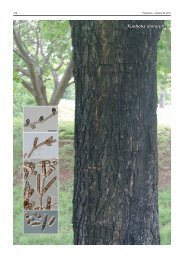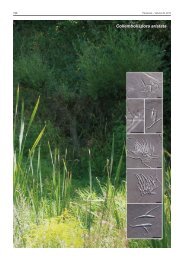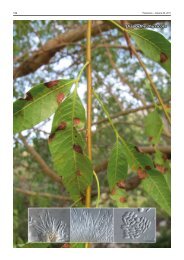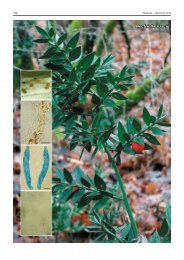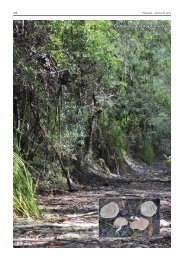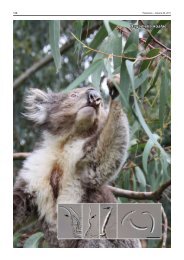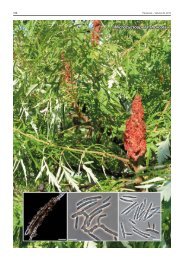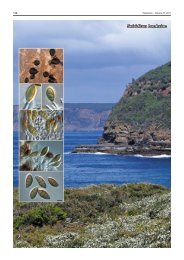Phyllosticta aristolochiicola - Fungal Planet
Phyllosticta aristolochiicola - Fungal Planet
Phyllosticta aristolochiicola - Fungal Planet
You also want an ePaper? Increase the reach of your titles
YUMPU automatically turns print PDFs into web optimized ePapers that Google loves.
154 Persoonia – Volume 29, 2012<br />
<strong>Phyllosticta</strong> <strong>aristolochiicola</strong>
<strong>Fungal</strong> <strong>Planet</strong> description sheets<br />
155<br />
<strong>Fungal</strong> <strong>Planet</strong> 131 – 20 December 2012<br />
<strong>Phyllosticta</strong> <strong>aristolochiicola</strong> R.G. Shivas, Y.P. Tan & Grice, sp. nov.<br />
Etymology. Name derived from the host plant genus, Aristolochia (Aristolochiaceae).<br />
Leaf spots amphigenous, circular, up to 1 cm diam, grey to<br />
pale brown, solitary, surrounded by a slightly raised black<br />
border about 1 mm wide; centres of lesions often tear or fall<br />
out producing symptoms of shot-hole. Conidiomata pycnidial,<br />
mostly epiphyllous, black, solitary, unilocular, globose, 40–70<br />
μm diam, erumpent; wall composed of layers of textura angularis,<br />
outer layer dark reddish brown. Conidiophores reduced<br />
to conidiogenous cells or with a supporting branched cell. Conidiogenous<br />
cells terminal, hyaline, smooth, subcylindrical to<br />
ampulliform, 10–20 × 2–4 μm. Conidia globose, subglobose,<br />
broadly ellipsoidal or obovoid, with a truncate base and rounded<br />
apex, hyaline, 7–16 × 6.5–11 μm, aseptate; wall uniformly<br />
0.5–1 μm thick, enclosed in a mucilaginous sheath, with a<br />
minute basal frill and an apical hyaline tapered appendage<br />
3–7 μm long. Teleomorph not observed.<br />
Culture characteristics — (after 1 wk in the dark and a<br />
further 2 wk under 12 h ultraviolet light / 12 h dark cycle, at<br />
23 °C): Colonies on potato-dextrose agar 4 cm diam, flat with<br />
no aerial mycelium, olivaceous black (Rayner 1970) with a<br />
white-grey, 2 mm entire margin, narrowly zonate towards the<br />
margin.<br />
Typus. Australia, Queensland, Kuranda, Kennedy Highway, on leaves<br />
of Aristolochia acuminata, 1 Apr. 2010, K.R.E. Grice & P. Wright (holotype<br />
BRIP 53316a; includes ex-type culture), ITS sequence GenBank JX486129,<br />
LSU sequence GenBank JX486128; Queensland, Emmagen Creek, Cape<br />
Tribulation National Park, 1 Aug. 1993, R.G. Shivas, paratype BRIP 21785,<br />
MycoBank MB801322.<br />
Notes — Species of <strong>Phyllosticta</strong> have Guignardia sexual<br />
morphs, and are common endophytes or pathogens, occurring<br />
on a wide range of plant hosts (Glienke et al. 2011). Two<br />
species of <strong>Phyllosticta</strong>, P. aristolochiae on A. clematitis and<br />
P. aristolochiae (replacement name P. tassiana) on A. sempervirens,<br />
have been described from Aristolochia. Neither<br />
species was considered a <strong>Phyllosticta</strong> in a more recent revision<br />
of the genus (van der Aa & Vanev 2002). Furthermore,<br />
the latter name and its replacement name (P. tassiana) were<br />
both homonyms and thus both are illegitimate (van der Aa &<br />
Vanev 2002). <strong>Phyllosticta</strong> <strong>aristolochiicola</strong> was first collected<br />
in north Queensland in 1993 in association with leaf spot and<br />
shot-hole of Aristolochia (Shivas & Alcorn 1996). Based on a<br />
megablast search of NCBIs GenBank nucleotide database,<br />
the closest hit using the ITS sequence is <strong>Phyllosticta</strong> cordylinophili<br />
(GenBank AB454357; Identities = 591/612 (97 %), Gaps<br />
= 5/612 (1 %)), followed by Phyllostica ardisiicola (GenBank<br />
AB454274; Identities = 584/614 (95 %), Gaps = 10/614 (2 %)),<br />
and Guignardia vaccinii (GenBank JQ936158; Identities =<br />
583/614 (95 %), Gaps = 6/614 (1 %)). Using the LSU sequence,<br />
the closest hits are to <strong>Phyllosticta</strong> abietis (GenBank<br />
EU754193; Identities = 1311/1328 (99 %), Gaps 0/1328 (0 %)),<br />
followed by <strong>Phyllosticta</strong> bidwellii (GenBank DQ678085; Identi<br />
ties = 1299/1313 (99 %), Gaps = 0/1313 (0 %)), and <strong>Phyllosticta</strong><br />
minima (GenBank EU754194; Identities = 1291/1303<br />
(99 %), Gaps = 0/1303 (0 %)).<br />
Colour illustrations. Aristolochia acuminata with leaf spots associated<br />
with P. <strong>aristolochiicola</strong> at Kuranda, northern Queensland; leaf spot with pycnidia;<br />
3 wk old culture on potato-dextrose agar; conidiophores and conidia;<br />
conidia with appendages apparent. Scale bars (from top left to bottom right)<br />
= 1 mm, 1 cm, 10 µm, 10 µm.<br />
Roger G. Shivas & Yu Pei Tan, Biosecurity Queensland, Ecosciences Precinct, Level 2C East, GPO Box 267, Brisbane 4001, Queensland, Australia;<br />
e-mail: roger.shivas@daff.qld.gov.au & yupei.tan@daff.qld.gov.au<br />
Kathy R. Grice, Agri-Science Queensland, PO Box 1054, Mareeba 4880, Queensland, Australia; e-mail: kathy.grice@daff.qld.gov.au<br />
© 2012 Nationaal Herbarium Nederland & Centraalbureau voor Schimmelcultures




